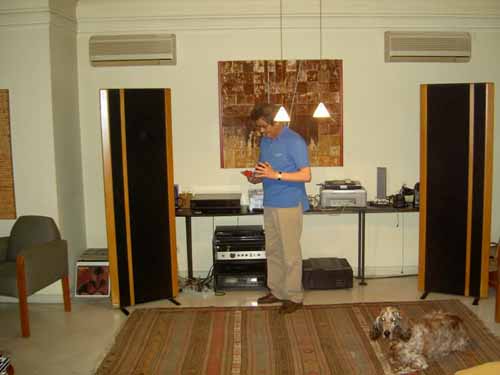It just happens to be a part of this job. Once you have everything sounding very much to your satisfaction, and you begin wondering what it would be like to start inviting record producers in and con fronting them with what their work really sounds like, it's time to throw everything out and begin anew. Therefore, the Yellow Room's new principal loudspeakers are Magneplanar 3.5's, the as-yet-unannounced successors to the 3.3's, replacing them as the company's next-to-largest offering. I confess to a long fascination with planar-diaphragm speaker de signs, having been astonished by how marvelous they can sound when sensitively installed, and .how abominable when they're put just any where. The difference lies, of course, in the treatment of the speakers' rear radiation, normally identical to the front, which will bounce back from the wall behind them to interfere catastrophically with what the device is trying to project into the listening area. Any speaker is subject to some of this sort of degradation but with a planar-diaphragm type, the back reflections don't even have to ooze their way around a cabinet to do their damage. They will come right through the diaphragm, which is, after all, only a flimsy sheet of plastic film.

above: Magneplanar 3.5 R in a typical listening room. (Source: audiokarma.org)
I anticipated many an exasperating hour lugging the 6-foot Maggies here and there to locate their sweet spots, but in that I was disappointed. The structural irregularities of the Yellow Room (window casements, strange junctions of walls and ceiling) seemed to disorganize the back reflections so effectively as to make the very first experimental placement quite delightful--with some reservations. The first of these had to do with …well, let's call it "bigness." The Maggies are large objects, to be sure, but their working parts are as massless and insubstantial as gift wrap, leading one to expect a certain retiring delicacy in their emissions. Instead, "My God, it's like the fifth row in a movie theater," remarked one visitor, and his assessment was correct, except that the overall sound quality was infinitely better. Another suggested that the whole wall had come alive with music, which was fascinating in its way, but not easily reconcilable with the modern concert-hall experience, in which the whole stage may bloom with sound but that stage remains a relatively small portion of the entire auditorium. Here, the stage had been brought into the room, and the room was not really big enough for it.
It's probably time to point out that the above comments have nothing to do with stereo imaging, or "sound staging," as it is now often called. The Maggies keep the violins precisely in place, very much up front and to the left, and the percussionists remain fixedly in back, to the point where you can almost sense them playing cards during the slow movement. There are no spatial distortions unless they are contributed by the recording.
Nor is there any sort of "forwardness," often associated with an aggressive upper midrange. The upper midrange is handled by a ribbon tweeter, 4 feet tall, about a centimeter wide, and not thick enough to be worth talking about. Magnepan says it's dead flat to 40 kHz, and you readily believe it when you hear it, This is the sort of tweeter that draws you in instead of driving you away. And so does the rest of the system. But its overall presence, its "thereness," makes you wish you had bothered to shave before you started listening, lest a musician step out to introduce himself.
A second cavil was anticipated: lack of low-frequency extension, as is inevitable with almost any dipole loudspeaker of less than enormous dimensions. These Maggies do full justice to the string bass, but at the lower frequencies plumbed by many orchestral bass drums, pipe organs, and synthesizer compositions, your imagination must provide the floor shakes and tummy massages. A subwoofer to handle the lowest audio octave would seem a likely fix, but getting a cone driver to "join up" satisfactorily with film-diaphragm elements has often proved puzzlingly difficult.
My strong suspicion is that the crudely horn-like configuration of the Yellow Room's sending end has a lot to do with the potency of the Maggies' projection, but I have heard from some colleagues that they can verge on the overwhelming in other listening environments. A major problem with saying more is that not many people have heard Magneplanar speakers anywhere, and very few have heard them in their homes. The company is small, the dealers not numerous, and the setup in showrooms that do have Magnepan products can be very disadvantageous. Magazine reviews are scanty. For these reasons, and others, I'd like to call your attention to them on this page. They possess all the favorable sonic attributes of full-range electrostatics at a minimum of cost (about $3,200 a pair [late 1993]) and complexity, and what they can do, bass limitations considered, is probably as much as could be expected from any loudspeaker. The thing is that, for some, they might do a little too much of it.
Source: Stereo Review (01-1994) BY RALPH HODGES